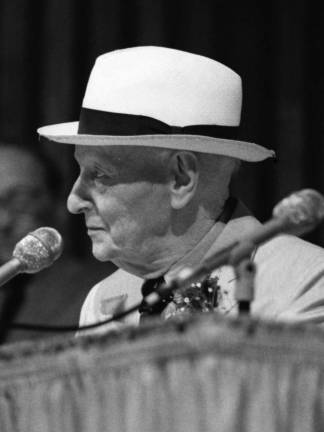Isaac Bashevis Singer’s Upper West Side

When Americans think of authors who wrote in Yiddish, the traditional language of Eastern European Jews, the late Isaac Bashevis Singer is among the first to come to mind. Singer, who came to America from Warsaw in the mid-1930s, was incredibly prolific, writing about 20 novels and 12 story collections and received the Nobel Prize in Literature in 1978.
His best-known works deal with his childhood and early adulthood in Poland, or with the history of pre-World War II Polish Jewry. In particular, he was celebrated for his stories about the imps and demons that were part of the folk beliefs of small-town Eastern European Jews when he was growing up. But starting around 1970, more and more of his published works dealt with his experiences in America. And for Singer, America largely meant the Upper West Side.
During his first few years in the new country, Singer lived in picturesque Sea Gate near Coney Island, another area that for which maintained an attachment for his entire life. After his marriage to Alma Wassermann in 1940, he lived on Ocean Parkway in Brooklyn for about a year.
The couple then moved to Central Park West, just north of 100th Street. In 1962, shortly after Singer was mugged at gunpoint in his lobby, they moved to West 72nd Street. Three years later, they moved to The Belnord, the massive apartment building on Broadway and West 86th Street. According to some accounts, one of the reasons he liked The Belnord was that it has an inner courtyard, just like apartment buildings in his familiar Warsaw. At least until he received the Nobel, his name was still listed in the phone book.
Singer had several regular haunts on the West Side. One of them was Steinberg’s on Broadway near 82nd Street. One writer, who met Singer in the early ‘60s, remembered him going to Steinberg’s, pointing out the middle-aged Jewish intellectuals who hung out there and telling him who was having an affair with whose wife or husband.
Another, according to The New York Times, was the Famous Dairy Restaurant, on 72nd Street. Steinberg’s and the Famous were both Jewish restaurants, known for their chopped liver, cheese blintzes, potato pancakes, herring and borscht. The Times article recalled that he always asked his favorite waiter the same question, “What’s for lunch?” and the waiter always had the same answer, “The soup is mushroom and barley and the liver is on whole-wheat bread.” Singer, a vegetarian and an early animal-rights advocate, would invariably order the meatless version of the chopped liver sandwich — “a concoction,” The Times reported, “of carrots, peas, string beans and onion,” and the soup.
Singer also frequented a more conventional New York coffee shop, the American Restaurant on Broadway and 85th, where he and wife would have pea soup, a boiled potato and rice pudding. Aside from restaurants, Singer, would regularly feed pigeons in the median on Broadway. During his walks, he was very accessible — my wife, Rhea, met him in the American sometime in the ‘70s or early ‘80s, and he told her in a heavy Yiddish accent, “I wish I had time to talk to you. I love my readers!”
Singer’s American characters are aging members of the Yiddish-speaking intelligentsia: writers, actors, professors, occasionally a businessman or a doctor. In most cases, they are survivors of Hitler’s camps (and sometimes Stalin’s as well), or else came to the U.S. shortly before the Holocaust, as did Singer. His best-known novel set on the Upper West Side is “Shadows on the Hudson,” serialized in the Yiddish Forward in the 1950s, then published in English in 1997.
The novel begins with a dinner given by Boris Makaver, a wealthy real-estate investor and an observant Jew. It doesn’t take long for one of Singer’s main themes, infidelity, to rear its head (Singer himself was known for having many mistresses). The main character, Hertz Grein, a former math prodigy who is now a stockbroker, is involved with several women at the same time. Another of Singer’s favorite themes is the occult, and in this book it is represented by Dr. Henrietta Clark, a dentist who dabbles in the paranormal and holds séances at her home.
Probably his best-known short story that takes place on the Upper West Side was “The Cafeteria,” which was published in “The New Yorker” in 1969 but takes place in the 1950s. The story revolves around Esther, a woman in her 30s who suffered through both German concentration camps and Russian prison camps and who now hangs out at a cafeteria on Broadway. One day, she tells the narrator that she has seen Hitler, surrounded by a group of Nazis in white robes, in the same cafeteria. A year or so later, on his way to the subway, he glimpses Esther, looking happier than he’s ever known her, in the company of a much-older acquaintance whom the narrator believes had died long ago. When narrator returns to the cafeteria, he is told that Esther committed suicide.
Most of Singer’s West Side haunts are now gone. If you wish to honor him, take a walk down Broadway, feed the pigeons and eat some traditional Jewish food. Singer wouldn’t want you to eat pastrami, corned beef or other meat dishes — but fruit compote, cheese blintzes and mushroom-barley soup would do very nicely.